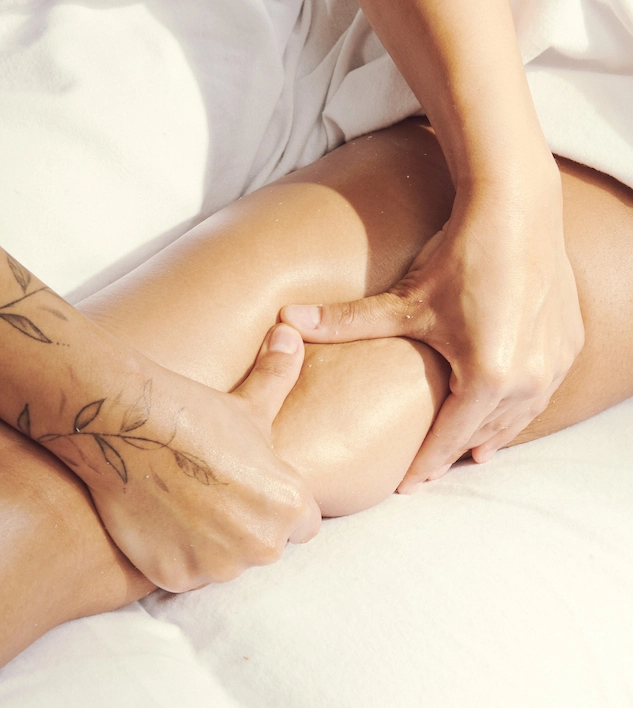Lymphatic drainage and anti-cellulite massage – what’s the difference?
About this post
Often confused, but really very different. Let's compare lymphatic drainage and anti-cellulite massages
Posted by
ClaireKey takeaways:
Lymphatic drainage frequency: For general health, monthly treatments work well. If you have immune system conditions or are on medication, you can increase to 2-3 times a week.
Hydration and rest: After a session, stay hydrated and get plenty of rest to help your body flush out toxins.
Ideal for detox: Lymphatic drainage helps with toxin removal, reducing swelling, and boosting immunity.
Lymphatic drainage and anti-cellulite massages are often confused. To those in the know, that’s fairly surprising, given that there are so few similarities between them. In fact, the two treatments are fundamentally different in their approach and the types of benefits they offer. Here’s a quick rundown of both to help you decide which one suits your needs.
What does lymphatic drainage do?
Lymphatic drainage is a technique that moves lymph, the fluid responsible for fighting bacteria and infection in the body, towards lymph nodes. Those nodes then filter the lymph and expel any toxins.
The process also encourages the body to produce more lymph, bolstering the immune system and your body’s ability to fight infection. The treatment uses light pressure, so it’s also a great way to relax.
How is lymphatic drainage performed?
Lymphatic drainage is characterised by therapist's extremely light touch. That’s because lymph, the fluid responsible for fighting bacteria in the blood, sits fairly shallow under the skin. Forming a circle or V shape with their hands, therapists move upwards towards the core in long, slow, regular motions. Proper practice is to maintain contact with the body through these motions to move the lymph along.
Therapists typically begin the treatment by working the neck area to open up lymph nodes. Once the nodes are open, practitioners work to move fluids towards them from all around the body.
For the treatment to be fully effective, a minimum 90-minute massage is recommended – two hours is ideal.
Oh, and by the way, the rumours are true – it’s not uncommon to feel the need to pee during or after a lymphatic drainage treatment. That’s just your body working to expel toxins.
What to do after lymphatic drainage
Get lots of rest, and stay hydrated to help your body flush out toxins and waste. Drinking a warm glass of water with lemon first thing in the morning is also a good idea – it’ll help with liver function.
How often should I go for lymphatic drainage?
Getting into the habit of booking lymphatic drainage once a month is a great idea. If you’re suffering from any conditions that affect your immune system, or if you’re on any medication for those sorts of illnesses, you can step up treatments all the way to two or three times a week. It all helps!
What does an anti-cellulite massage do?
Anti-Cellulite treatments don’t have the same light touch as Lymphatic Drainage. That’s because practitioners are working to stimulate blood flow to fight water retention and dimpled skin caused by cellulite. You’ll walk away feeling lighter, slimmer, and smoother.
How is an anti-cellulite massage performed?
At this point, it’s worth noting that there are three types of cellulite:
Water-based cellulite – the most common form of cellulite caused by poor circulation, sitting for too long and not drinking enough water
Combination cellulite – comprised of a mixture of water-retaining cells and fat cells
Fat-based cellulite – cellulite comprised of fat cells only
To treat all types of cellulite, therapists use a broad variety of techniques including pounding, circular motions and kneading. Skin-rolling (or palper-roulé), is another technique they’re likely to use – that’s the practice of pinching and rolling the skin to drain fluids out. They'll work energetically to boost blood flow to the skin’s surface.
Your therapist will need to adjust their levels of pressure depending on the type of cellulite they’re treating. For fat-based cellulite, the treatment may be slightly uncomfortable as practitioners really work to get blood to that area. Water-based and combination cellulite is easier to treat, and pressure is normally medium.
Sessions typically last an hour, and often therapists are tired by the end! In that time, they’ll aim to treat your thighs, arms, gluteus, calves and lower back. They can also treat the tummy area, though with a more gentle touch – they’ll ask permission first for that.
What to do after an anti-cellulite massage
It’s important to stay hydrated so the body doesn’t immediately replenish the water released by the massage. Exercise to increase blood flow helps to keep cellulite away in the long term, as will lowering the amount of fat and sugar in your diet. You can book Anti-Cellulite treatments as often as once a week to keep the progress coming.
For an even better booking experience, download the Urban app and book massage, physio, facials from your phone, to your home.
Make life easier